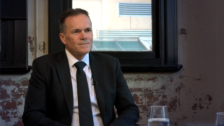“Jury is still out” on China returning to economic leadership
Anyone shopping for basic goods or reading the papers in recent months has likely had more than enough of the “supply chain issues” that many businesses are facing. While many of these are self-inflicted, whether due to our closed borders, the running-down of inventory or a plethora of other issues, they are indeed real. Unfortunately, they are unlikely to end anytime soon.
It only takes a quick look to our north, at China, to see the growing risk of its “COVID Zero” approach, in which entire cities continue to be locked down to fight the Omicron wave. Given the Winter Olympics is about to kick off, there is little hope that lockdowns will end and as a result, and the shortages we see today may not be as short-lived as we had hoped.
China has seemingly always marched to a different beat to the rest of the world, but regardless, “China as a single country has determined around 30 to 40 per cent of annual global GDP growth.” according to Peter van der Welle, strategist within the global macro team at Robeco.
Warning that “lockdown intensity could increase in China in the near term,” he suggests that this could “additionally suppress domestic demand,” placing growing pressure on the Chinese government to “flex its policy muscle.” Concern about just what this “muscle flexing” might entail, and its timing, is likely to keep investors cautious until the domestic economy garners more growth.
China’s contribution to global growth faltered in 2021, as a “policy-induced deceleration” put pressure on the domestic economy, but particularly the real estate, manufacturing and infrastructure sectors,” allowing developed economies to get “caught up.” The big question, however, is where to, now?
“The country has initiated several tough policy actions and launched its Common Prosperity program to tackle the main threats to both growth and internal stability” says van der Welle, with the fate of the Chinese economy to become all the more important for the globe. Investors have been deserting the Chinese market for months now, but green shoots are beginning to show as the policy view shifts.
The launch of the Common Prosperity program, which focused on reducing inequality (which is on par with the US) has been a major cause of concern, due to so-called “regulatory interventions.” But China’s leadership remains fixated on reducing “social unrest” rather than boosting the domestic economy. This stands out as the potential driver of an important 2022.
Van der welle says “the Common Prosperity program is concentrated around three troublesome sectors….notably real estate, technology and education,” in which “implementation is key.”
“For instance, the People’s Bank of China’s (PBOC’s) three ‘red line’ policies – a liability-to-asset ratio of less than 70%, a net gearing ratio of less than 100%, and a cash-to-short-term-debt ratio of more than 1 times – amounted to forced deleveraging in the real estate sector. The most infamous casualty of this was Evergrande, which is now entering a debt restructuring process.”
With plenty of capital ready to flow into China in the event that the outlook for “intervention” improves, it is more difficult than ever to “read the tea leaves,” says van der Welle. That said, the recent decisions to ease the reserve requirement ration and increase fiscal stimulus are a step in the right direction.
“Although it is increasingly likely that deleveraging, decarbonization and housing wealth deflation is going to take a backseat as we enter 2022, we remain in the wait-and-see mode,” says van der Welle.
“Although China’s policy muscles have clearly been flexed, the jury is still out on whether they can still do the heavy lifting.”











